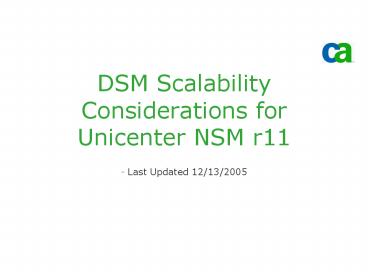DSM Scalability Considerations for Unicenter NSM r11 - PowerPoint PPT Presentation
1 / 27
Title:
DSM Scalability Considerations for Unicenter NSM r11
Description:
Each managed host may spawn dozens of objects. Agents. Watchers ... Type of host activity. Web server. Application server. Database server. Batch server ... – PowerPoint PPT presentation
Number of Views:25
Avg rating:3.0/5.0
Title: DSM Scalability Considerations for Unicenter NSM r11
1
DSM Scalability Considerations for Unicenter NSM
r11
- Last Updated 12/13/2005
2
Objectives
- Understand issues affecting DSM performance
- Understand issues affecting scalability
- Consider architectural options
- Recommendations
3
Issues affecting DSM performance
4
Understand issues affecting DSM performance
- Hardware
- Local vs remote DSM(s)
- Cold start vs. warm start
- Electronic proximity to hosts
- Network configuration and congestion
- Number of hosts
- Number of managed objects
- Polling configuration
5
Hardware
- See Hardware Requirements in NSM r11
Implementation Guide for latest guidance
6
Hardware
- Does hardware matter?
- 30,000 objects 2 subnets with 50 objects per
host
7
Local vs remote DSM(s)
- For smaller implementations a local DSM on the
MDB machine is OK - For larger implementations, remote DSM(s) should
be strongly considered
8
Local vs remote DSM(s)
9
Multiple Remote DSMs
- Multiple remote DSMs have a synergistic effect
10
Local vs remote DSM(s)
- Local and remote DSM not as strong
11
Cold start vs. warm start
- Set WarmStartyes option in AGENTWORKS_DIR\ser
vices\config\atmanager.ini - Warm start uses previously discovered objects
- Reduces MDB access time
- Reduces discovery process time
- Must still confirm status
12
Cold start vs. warm start
- Startup measured as time to DSM settling
DSM start complete
13
Cold start vs. warm start
- Startup elapsed times
14
Electronic proximity to hosts
- Standard best practice not more than 3 hops
- High performance LAN access to hosts and MDB
- Avoid WAN links
15
LAN Polling
16
Network configuration and congestion
- DSM should usually handle whole subnets
- Fast/stable path to MDB
- Network utilization
- Errors, timeouts, and retries
- Size counts
17
WAN Polling
18
Number of hosts
- Affects startup and first stage discovery
- Affects total DSM object population
- Affects DSM host configuration
19
Number of objects
- Each managed host may spawn dozens of objects
- Agents
- Watchers
- Split DSMs to keep number of objects constrained
- Split DSMs to keep electronically close
20
Polling configuration
- Polling interval
- Polling rate for r11 DSM sustained at up to 1,000
polls/second (laboratory only) - Speeds discovery (?)
- Not needed for status polling
- 10 to 20 minutes polling still best practice
- 50,000 poll-able objects at 10 minute polling
interval is about 80 polls/second - Timeouts are critical
- Assume timeout 10, retry 2 30 second delay
- DSM thread waits for reply or timeout on SNMPGET.
- IP policy makes extensive use of SNMPGET
21
Polling configuration
- Calculating polling rates
- Target no more than 50 utilization in polling
interval - 200/sec five minute interval is 300 seconds so
do not attempt more than 30k polls in five minute
interval (300 seconds X .50 X 200 polls per
second) 60k objects polled every 10 minutes - Configure aws_snmp MaxPollRate in atservices.ini
22
Issues affecting scalability
23
Issues affecting scalability
- Hardware
- What hardware is available?
- Can it support MDB DSM?
- Network
- How electronically close are managed objects?
- Is there capacity to handle polling and trap
traffic? - How reliable is the network?
- Geographic proximity
- Do managed objects exist on other side of WAN?
- Polling
- What are the polling requirements?
24
Issues affecting scalability
- Type of host activity
- Web server
- Application server
- Database server
- Batch server
25
Architectural options
26
Architectural Options
- Local DSM
- Fine for smaller shops
- Add remote DSMs as necessary
- Add remote DSMs to improve performance
- Use several smaller DSMs
- Closer to managed objects
- Faster startup
- More robust (not single point of failure)
- Reduces effect of an outage
- Bridged MDBs
- Distribute MDBs for better DSM access
27
Questions?































